As I write this, it’s been over 7 weeks since I returned from China. I’ve sat down and tried to start writing about my experience a number of times, but to be honest, it’s been hard to get all of my feelings and experiences down without it becoming total word vomit or just a complete photo dump. It was an 11-day sensory explosion of new sights, tastes, feelings, and friends. But when I sit back and try to think of one word to sum up the whole trip, what keeps coming back over and over is the word “love.”
This may be 100% cliche, but I’m going to say it anyway: I fell in love with China in a way that I never expected.

It’s possible that if my first trip abroad had been to, say, Finland, or Australia, or Brazil, that I would say the exact same thing about any of those countries. But I truly think there’s something special about China, something that is often overlooked by Westerners, and particularly Americans. But if you look past political relations and media portrayals, you will find a country full of welcoming, friendly people, a land that is both ancient and ultra-modern, a place that is easy to fall in love with the way I did.
I want to delve into every aspect of this trip, and it will take more than one post. To start, here is a recap of the start of our trip and our first couple days in Beijing!
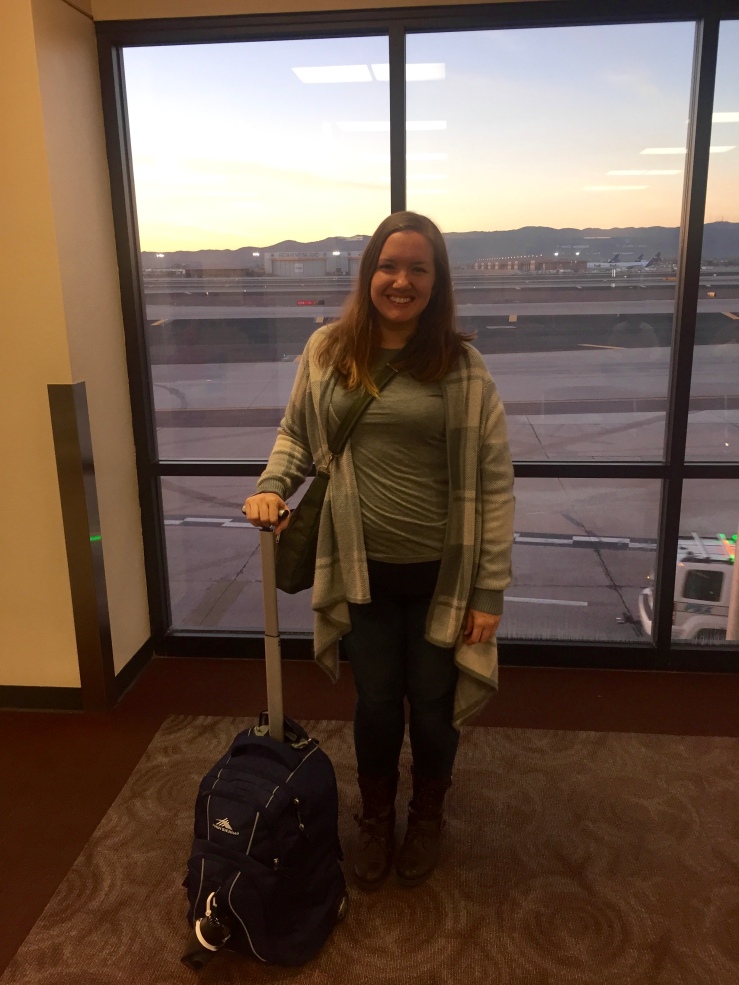
Eric and I set out very early on December 5 and flew from Phoenix to Seattle, then Seattle to Beijing. In total, we were in the air for about 15 hours, but door to door it was about 20 hours of travel time. But instead of exhaustion, we were both feeling thrilled, excited, and anxious for the trip to come. This was, after all, our first time in a new country on a new continent!
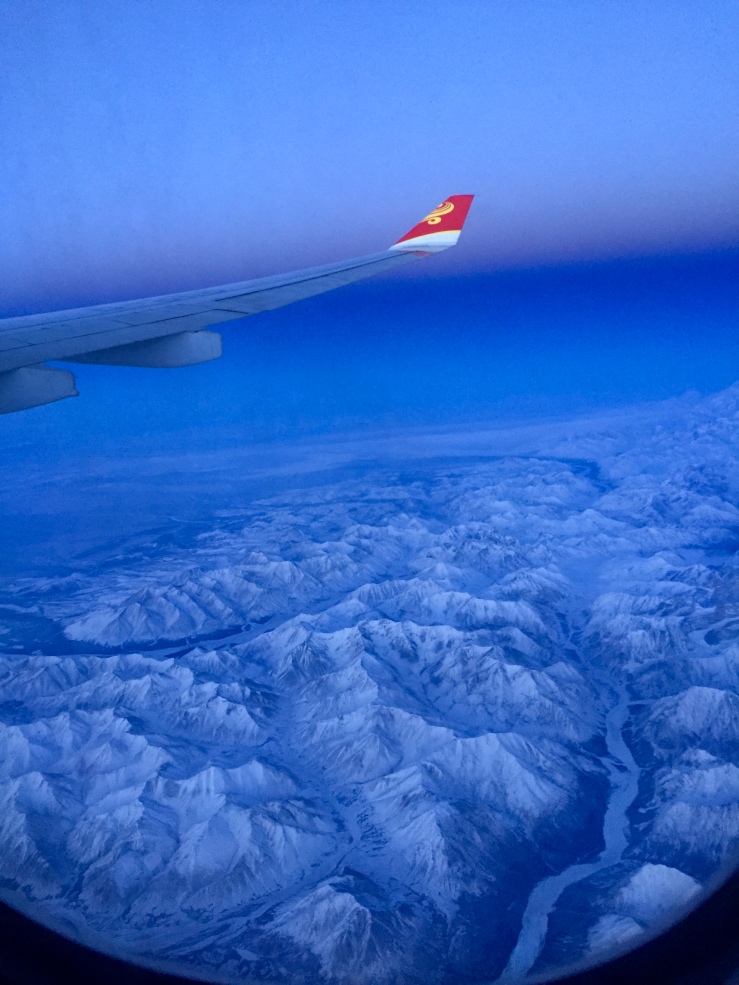
We saw amazing views from the plane as we flew over British Columbia, Alaska, Russia, and northern China. We landed in Beijing in the evening on December 6th, went through immigration and customs, and got to our hotel just before 8pm. But we were in Beijing! We weren’t ready to just go to bed.

So we got out of our hotel and explored a bit. We were staying very close to Wangfujing Snack Street, a short street famous for its food vendors selling everything from dumplings and ramen to fried scorpions and starfish. Let me tell you, it was some serious sensory overload. Everywhere we went, vendors were calling out to us, trying to get us to buy their food, and neither of us really knew what we wanted. So we ended up walking to the end of the street and finding a little convenience store, where we bought a couple beers and regrouped. We decided to brave Wangfujing again, if for no other reason than that we really wanted to eat something.

Eventually, we found that something: spicy beef noodle soup and pork dumplings. The spicy noodle soup was steaming hot and deliciously spicy, which was perfect on a cold December night in Beijing. The dumplings were okay, but not the best I had on this trip. Still, not a bad start, food-wise!
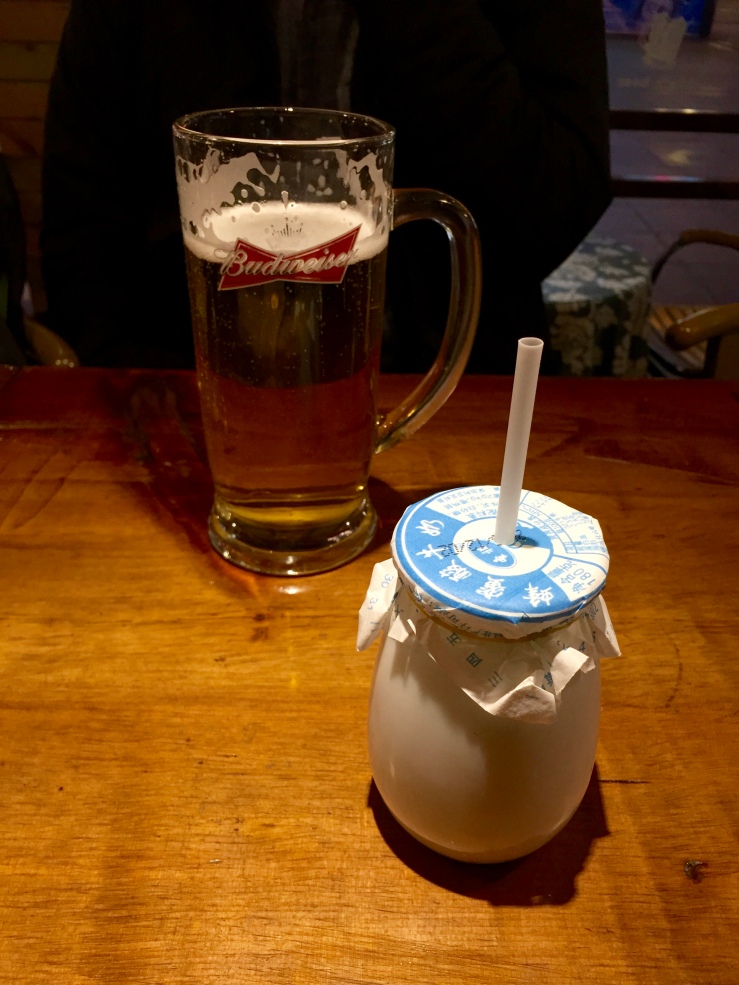
Wangfujing Snack Street shuts down promptly at 9:30pm, so we walked back to Wangfujing pedestrian shopping street (the snack street is a tiny offshoot that runs perpendicular to Wangfujing Shopping Street, one of Beijing’s most famous commercial shopping streets). After being approached by a well-dressed woman offering to be our tour guide, show us around and, I kid you not, “find you a beautiful woman to sleep with” to Eric (bitch, I will fight you!) we found what I can only describe as a small glass Budweiser cafe in the middle of the pedestrian street. So you know we had to go see what this was about. Neither of us care for Budweiser, but Eric got a pint and said it tasted more like a lager than any Budweiser he’s had at home. Who knows? Maybe they make it different in China. I got a yogurt drink, a popular Beijing street beverage, because I had to try it once–it reminded me of the probiotic yogurt drinks like Yakult.

The next morning, I woke up at 3:30am. Thanks, jet lag! I spent a lot of time reading about the day’s sites and watching some very, um, interesting TV: strange game shows, very dramatic historical reenactments, and an infomercial that seemed to be for men’s briefs that would give the appearance of more…girth. Finally as the sun came up, we were able to see the city around us. Our room overlooked a small hutong (a narrow street made up of traditional courtyard homes) and some apartment buildings, and to the west we could see the gilded rooftops of the Forbidden City. This was a smoggy day, but on a clear day we could even see the Yanshan mountain range (home to the eastern section of the Great Wall) to the north.
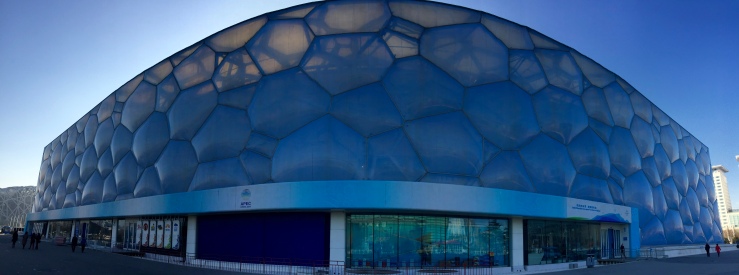
We started our day at the Beijing Olympic Park, home of the 2008 Summer Olympics and the upcoming 2022 Winter Olympics. To be honest, I wouldn’t have picked this if I were planning the itinerary (this was a guided tour) because it was just a lot of standing around, looking at the buildings, and taking pictures. However, it was a short stop and I am glad we went–what an amazing thing to see the scope of these buildings that I had previously only seen on TV!

The Bird’s Nest, for instance, is massive, something I never realized until I saw it in person. Plus, it was in 2008 when I was watching the Beijing Olympics that I thought, “I’d like to travel there some day,” so it was a pretty full-circle moment actually being there.

The park itself is three times the size of Central Park, but we just visited the two big sights: the Bird’s Nest (where the opening and closing ceremonies and track and field events were held) and the Water Cube (where swimming events were held). We also got to see the media tower and the Pangu 7 Star Hotel, which is designed to look like a dragon with a long tail.
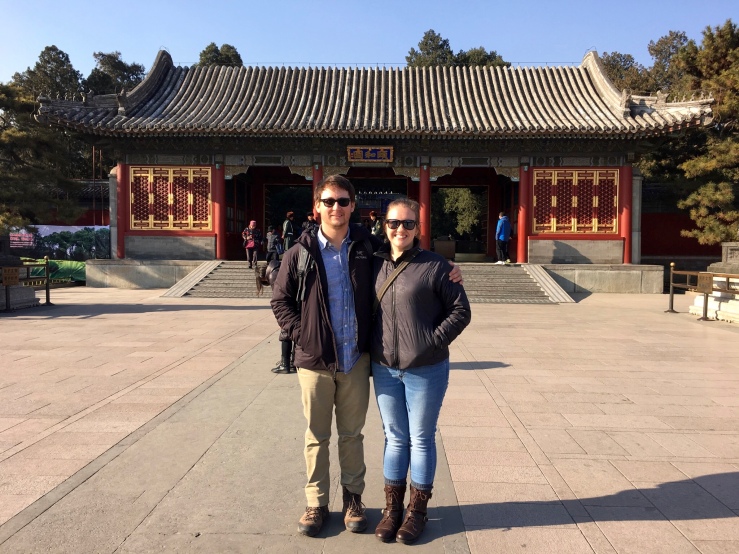
After the Olympic Park, we visited the Summer Palace. This was one of many UNESCO World Heritage sites we got to see in China and it’s a Qing-style imperial palace with a fascinating history. After being burned down by British troops in 1860, the Empress Dowager Cixi, who ruled in place of her infant son the Tongzhi emperor, used funds intended for the imperial navy to rebuild the palace as her own residence in the late 19th century.

Cixi lived a lavish lifestyle, and it’s apparent in the stunning Summer Palace, which is made up of beautiful halls, walkways, gardens, bridges, and Kunming Lake, which makes up 75% of the palace grounds.

I absolutely loved the Summer Palace. This was the first feel of old China that we got, even if much of it was rebuilt just over 100 years ago. Everything was ornately decorated and well crafted, like the Long Corridor, where every single inch of the beams, pillars, and ceiling is decorated with a unique hand-painted scene.

Everything was rich with blue, green, and red, all significant colors in Chinese culture past and present.

One of my favorite spots was where hundreds of dragon boats were lined up–our guide, Eva, kept urging us to return in the summer to see the Summer Palace in its full glory, when everything would be in bloom and we could ride a dragon boat on the blue-green lake to beat the heat. But next to these wooden boats was this mammoth marble boat. Obviously it doesn’t actually float (hi, marble) but it’s built to look like a huge boat, and its as a spot for the Empress Dowager to drink tea and sunbathe and live a generally carefree life–and it’s believed that she did this as a backhanded reference to the navy, whose funds she used to rebuild the palace. Oh, and they were destroyed in a battle with Japan shortly after the palace rebuild was finished, sooooo…

After lunch at a restaurant in a hutong courtyard home, we took a rickshaw ride through a hutong neighborhood in the Xicheng district. It was freezing, but definitely worth the ride, and we ended up at the back lakes, which were absolutely beautiful.

The tree-lined lakes were surrounded by small local bars, and I wish we’d had more of a chance to explore this area, because you know I love a good local bar (we still got to try a lot of local beers–don’t worry, I’ll have an entire post on what we drank in China!)
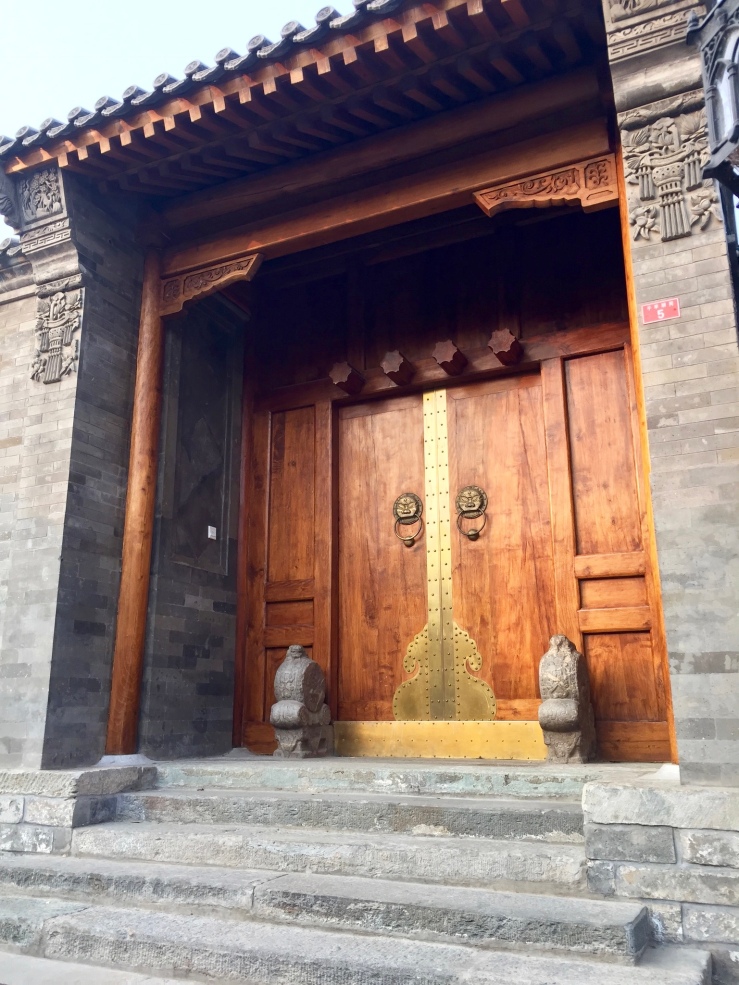
It was cool to see the entrances to courtyard homes of old and learn the meaning of the different courtyards. Here’s what I wrote in my travel journal about it:
“Eva explained the architecture of hutong courtyard homes. They have four rooms–one on each side of the courtyard. The seniors live in the South room because it gets the most sun. The sons live in the East room because sons are the hope of the family and the sun rises in the east. The daughters live in the West room because they will eventually marry into another family and nobody gave much of a shit about girls, to be honest. On the outside door leading into the home there are important status features. If they have 2 pillars/beams above the door, they are of medium social importance and wealth. If they have 4 pillars, they are very important and wealthy. If they have zero, they have low social importance and wealth. Members of different pillar statuses could not intermarry. Also outside some doors were small statues. Drums meant that a general or high ranking military official lived there. Books meant a dignitary or scholar. Many of the doorways have high thresholds. According to Eva, this is because the Chinese people believe that ghosts live among us, but instead of floating through walls, they can only hop. A high threshold prevents evil spirits from hopping over it and entering the home.”

That ended our planned tour for the day. Eric and I fully intended to explore the city that night–we have every intention of going out for a nice peking duck dinner and seeing a little more of Beijing. But we got back to our hotel around 4, decided to take a short nap, and slept until 10pm. Clearly we needed it–jet lag is no joke.
So there you have it! Our first two days in Beijing. There is so much more to share–this trip got better every single day, and I can’t wait to share more!
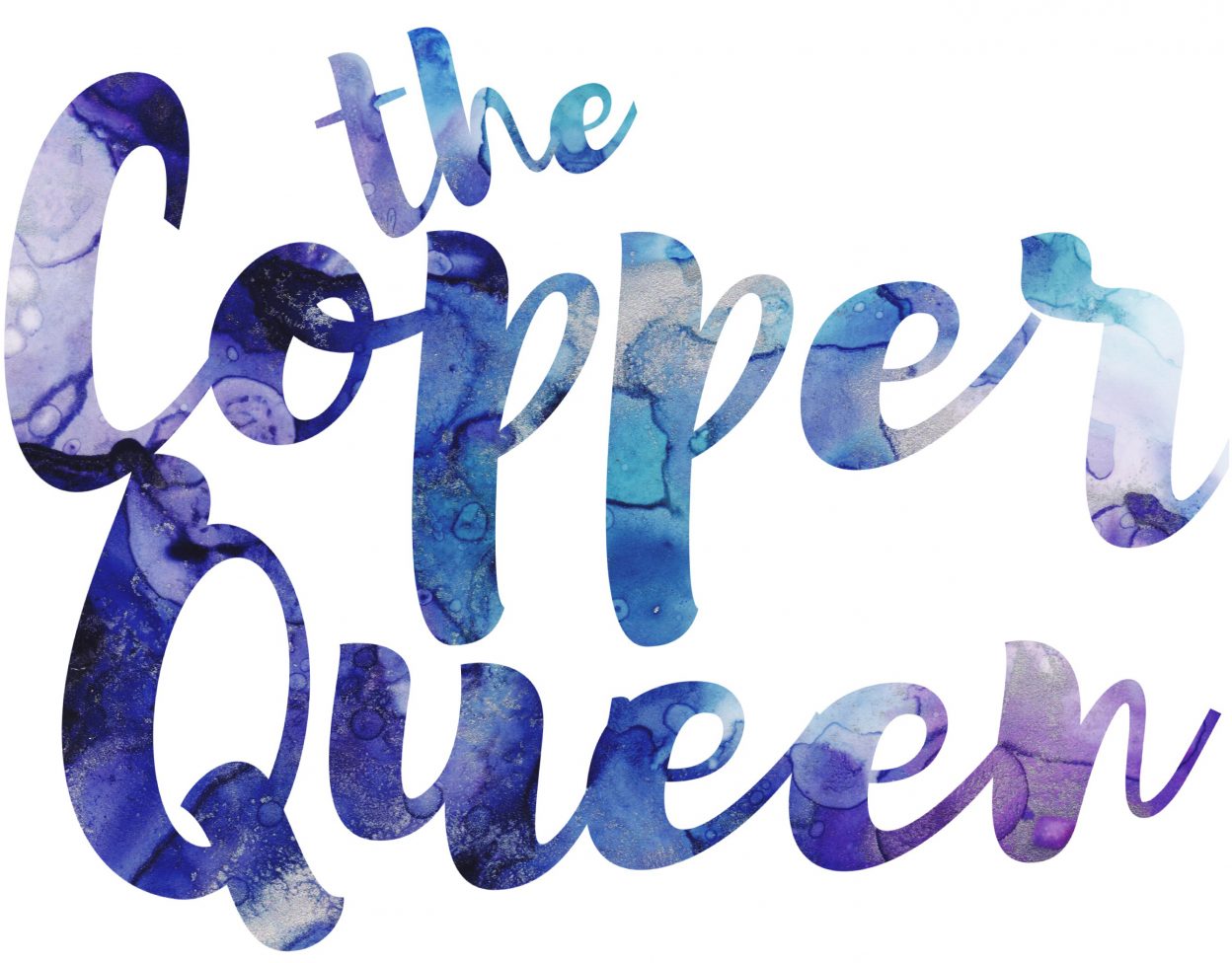

[…] to Chongqing after 3 epic days exploring China’s capital city (if you missed it, check out part 1 and part 2 of Beijing!) Truthfully, the Yangtze River cruise we were about to embark on was the […]
LikeLike